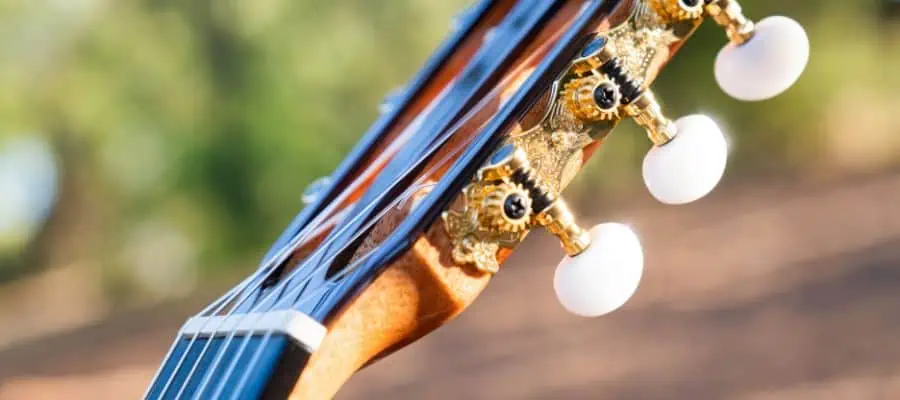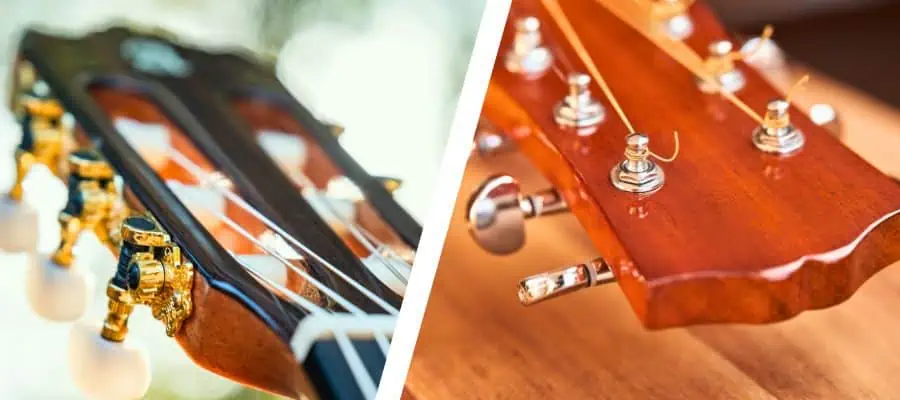The slotted headstock design is one of the most unique designs in the guitar world. With its distinctive appearance, characterized by slots or openings where the strings are inserted and secured, they add unique aesthetic aspects to instruments. However, slotted headstocks also have a functional and historical background.
Most commonly found in classical guitars, slotted headstocks have many reasons behind them, such as traditional craftsmanship, impact on string tension and tone, as well as aesthetic considerations.
Historically, classical guitars were initially built with slotted headstock designs, which became a tradition in the guitar world that many players and luthiers wanted to maintain. The next reason is the so-called break angle, which is the angle of the strings over the nut. On slotted headstocks, the break angle is steeper, leading the strings to exert more pressure on the nut, which means an enhanced and more powerful tone.
Slotted headstocks are timeless creations with these two main reasons behind the design. So, let’s explore the issue further to learn more about the history and the impact of slotted headstocks on classical guitars.
What is a Slotted Headstock?

Commonly found in classical guitars, the slotted headstock is a unique headstock design with two slots cut out of the wood slab. Opposed to the solid headstock design, they have holes and metal bars inside the headstock where the strings are wound around. It is the first headstock design classical guitars were built in history, and many consider slotted headstocks the traditional approach.
Why are Slotted Headstocks Used?
The main reasons behind the slotted headstock design are, first, the traditional approach and, second, its impact on tone. While the tone is related to the string break angle on the nut and is highly debated, the traditional approach is an aesthetical choice that many players enjoy.
Traditional Approach
The slotted headstocks are timeless designs, which is one of the main reasons they are still around. The historical tradition and craftsmanship are important for many players and luthiers. So, they like to maintain certain elements of the initial classical guitar design to reflect the origins of the instrument. The slotted headstock is one of those elements, as it is one of the first headstock designs.
First, classical guitars were mainly built with slotted headstocks, and soon it became a standard for the instrument. The design became so associated with classical guitars that today, many classical guitar lovers can not imagine a 12-fret classical guitar without the slotted headstock. It became a characteristic of classical guitars, and today, most classical guitars are still produced that way, with some contemporary exceptions.
String Break Angle

Another important yet highly debated reason behind the slotted headstocks is the string break angle and its impact on the guitar tone. On guitars with slotted headstocks, the strings have a steeper angle on the nut, which leads them to press harder onto the nut. More pressure means more energy into the instrument, providing an enhanced tone, as well as more clarity and liveliness to open strings.
However, this effect is highly debated in the guitar world, as some say the difference is not really hearable. Many guitarists do agree classical guitars with slotted headstocks tend to sound better, but they are not sure if this is due to the string break angle or other variables.
Aesthetics
As mentioned before, the slotted headstock design is heavily related to the taste of classical guitar purists. As tradition is important for any type of classical instrument, the same goes for classical guitars. They can not be considered without the classical slotted headstock design for many guitarists. And ultimately, they look pretty amazing, which is the reason they still persist in the contemporary world.
String Changing Process

While many argue the restringing process is more challenging with slotted headstocks, it is actually because they are not used to the design. Actually, the open slots offer easier access for restringing compared to the solid headstock designs. But, of course, this is a personal preference, and some would like one over the other.
The restringing process is actually quite similar between the solid and slotted headstocks. The main difference is that with slotted headstocks, you have to tie and loop the string to the bars on the slots instead of winding them to the tuning pegs, as in the case of solid headstocks. So, when you get used to the tying and looping process, it is quite easy to do. You can check the video to learn about the full restringing process.
Slotted Headstock vs. Solid Headstocks

Besides the aesthetical looks and slight effect on the tone due to the string break angle of slotted headstocks, there is no significant difference between the slotted and solid headstock designs.
In terms of tuning stability, they both offer the same performance. The tuning stability in classical guitars is related to different variables like the poorly cut nut or badly stretched nylon strings.
Classical guitars, in general, go out of tune quicker than acoustic guitars, and that is related to the nylon strings getting stretched easier than steel strings. So, the headstock design has no effect on tuning stability at all.
Conclusion
To summarize, classical guitars still come with slotted headstocks, mainly due to the traditional approach and aesthetic choices. However, there are many guitarists who believe the steeper string break angle over the nut plays a role in the tone as well as playability. It provides a better tone, especially noticeable on open strings, as they have more clarity and liveliness this way.
If you found this article useful, you may want to save this pin below to your Guitar board.

Recent Posts
Tuning your guitar to E Flat, also known as E♭ tuning or half-step-down tuning, involves lowering each string by a half step. This creates the notes E♭, A♭, D♭, G♭, B♭, E♭ or D#, G#,...
50 Campfire Guitar Songs To Ignite Your Next Singalong - Chords Included
Gathering around a crackling campfire with friends and a guitar is one of life's simpleest pleasures. Picture yourself strumming the chords as everyone belts out the chorus under a starry sky. From...

